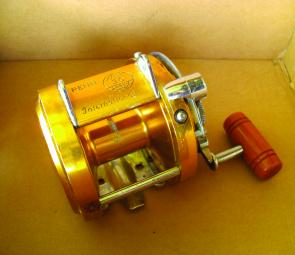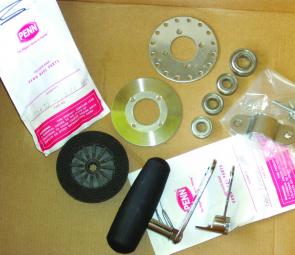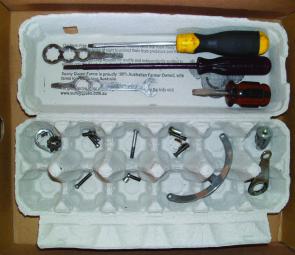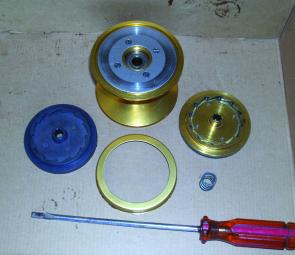If my article in the December edition of QFM inspired you to get into the mackerel fishing this summer; and if you are wondering what outfit you’ll use – how about the resurrection of a classic.
Rebuilding, tuning, upgrading, saving from the scrap-heap is all the rage these days. Resurrecting a reel using factory parts is a great way to embark on a hobby of making your reels as individual as you are.
There are lots of tricks to hot-roding fishing reels, and over time many of the improvements find their way into production reels. For example an old friend of mine, the innovative Brooks Morris, used to make custom T-Bar handles for Penn reels. His handle design was later sold to Tiburon.
If you need to occasionally push a reel to extract the maximum out of 50lb line then a ‘metal’ reel is my choice.
For mackerel I’m happy with single speed versions of metal game reels. This is because when fighting mackerel you normally only ever need to use the high-speed gear ratio of a two-speed reel; and commonly this is very close to the standard ratio in a single speed reel anyway. And, I prefer a lever drag for its ability to set light drag settings, such as for live baits, and then be further adjustable up to a preset strike drag and over the button for fighting drags.
When searching for a reasonably priced reel for my Aussie slow trolling for mackerel I thought, “Why not dust off the old Penn Internationals, tune them up a little and they’ll do the job perfectly!” The wear and tear on the family’s old reels had been exacerbated because they’d seen a bit of charter work too. But they are survivors; there are still plenty of ‘Inters’ around despite the original International 30 was first released in 1967.
I’ve been enjoying a lot of mackerel trolling in recent years, in all corners of the world. These days I tend to use smaller reels for the line’s breaking strain than I did 20 years ago. These days my mackerel reels are filled with braid backing and a top shot of mono line. In Australia that’d be at least 50lb braid backing, more like 65lb or 80lb braid, and a top shot of 50lb mono.
Over 20 years ago I used the original Penn 30 for 8kg and 10kg line; but that was before braid. A lot of things have changed in the world of fishing AB (after braid). To go from 8kg to 24kg line there is the need to tune the drag… more about that later.
Penn carry a great range of parts for their older reels so I was able to update two of my family’s own 30 year old reels, as well as a third that was traded with a mate after he had bought it off eBay and found that it was missing quite a few bits as well as a stuffed drag.
Updating an old reel can generate just as much pleasure as a new acquisition. This is even more so if the reel has a bit of history – maybe as a record breaker or if used by somebody famous. Restoring anything classic holds a lot of attraction; be it classic 4WD cars (fishing trucks), Queenslander houses, 1970s Haines Hunter boats and Penn fishing reels (there are heaps of internet chat boards devoted to the topics of Penn reel hot-roding).
The most common things to upgrade on the old Penn include drags and handles. The most common things that go missing include ratchet switches, reel seat clamps and the knob on the drag levers may be damaged – fortunately such parts are readily available.
The accompanying photo file shows the Penn International upgrade and restoration. Saving an old tired classic that was rescued and turned into a functioning modernised machine. Of course it got a clean and service (new greases and oils) while it was apart.
The internet is a good source of information for those who like to restore reels. My searches seem to always end up with me reading the sites based around the custom reel scene from the California coast of the USA. This region of the world is the hub of long range fishing for big fish using stand up tackle and the regulars have made serious hobbies of reel tuning. However like all internet chat boards, you’d be advised to read a lot of different opinions and double check before you launch.
I recommend Penn reels for this hobby because of their great spare parts availability.
Tip: Google the reel’s model number and the words “parts diagram” or “schematic” and you’ll be very likely to end up with an assembly diagram, parts layout and part numbers on your computer screen.
1. Opening the box to see what our mate sent us: The finish on the reel is certainly scratched up! But these Penn reels are tough and even if we don't restore the finish, as long as we get the internals humming then the reel will be back to its ol' workhorse self.
2. Always lay out the parts before you start, that way you can check if you've got everything; Dura-Drag and drag plates, bearings, modern offset handle, drag lever and reel seat clamping kit.
3. To keep track of your parts, place each item in an old egg carton in sequence as you take it apart. A range of screwdrivers and Penn's proprietary reel tools will get you through most aspects of the strip down and reassemble. It’s an oldie but a goody!
4. The following advice on drags I received from Thomas Blecker from Penn’s USA Service Department:
“Concerning the International drag systems, I would definitely go with the Dura-Drag system when refurbishing your Penn 30 International reel. You’ll find a much more consistent drag range, more drag pressure and the surface of the drag material will hold up much longer than the HT-100 drag will.”
The grey drag is the Penn Dura-Drag; the gold drag is the outside of the old drag (a throwaway item). Swap the gold out for the grey one and reassemble. I found that using the spindle (pushed through from the other side of the spool) helps keep the spring centred and aligned, note the anodised gold ring, and the spring.
The Penn International 30 (not the t, tw, s, sw, v models or any others), has a tricky-to-remove gold anodized drag cover. When you look closely you will see three tabs equally spaced around the rim on this cover that key in under a lip on the spool end. Push on one of the tabs and push in with the flat end of a screwdriver and pry/lever/lift very tentatively. The next tab should pop up similarly – especially if you rotate the cover a little in the keyway/lip, about one-third of a turn.
Putting the cover back on can be a little tricky, you need three hands and a screwdriver, but eventually it’ll all click into place.
5. This end plate shows the need for replacement parts on the drag lever; inside both end plates and each end of the spool will get new bearings.
The offset soft black handle has a number of features: the texture is grippy, the offset handle is counter balanced to offer itself in the ideal position for gripping when at rest and it has a longer stroke. The longer power stroke of the new handle and its ergonomic grip are great additions for those who wish to fish 50lb line (or heavier) off a 30 reel. However, the classic wood-look handle is a thing of beauty to many and one in good condition such as this one might get a few bucks from a collector.
Remove the preset plate by removing its three screws. Swap the old lever for the new lever and then reassemble.
6. I originally ordered a standard ‘smooth’ reel clamp, but then I found one of the saddles that came with a ring eye for the rod’s safety lanyard. The wing nuts on the seat bolts are favoured over the standard hex-nuts by many who regularly break the reels from their rods for travel and then reassemble for fishing. This is because the wing nuts can be more easily finger tightened.
7. Look out mackerel, here we come; the completed reel loaded with braid and mono. Penn’s gold reels last forever and their long service will repay you for the restoration over and over.
I built this reel for Aussie style trolling and live baiting for Spanish mackerel. Typically Aussie mackerel fishos use much larger hooks in their baits than the mackerel crews from the Atlantic (yet the fish are just as big in either locations). Because of these larger hooks Aussies can use heavier drag settings and thus heavier line than international crews who use small hooks and light drags.
Accordingly I built this 30 class reel ‘Aussie-style’ to fish 50lb line. A standard International 30 takes about 550m of 30lb mono and nearly 350m of 50lb mono; however I load the reel with 300m of 20lb diameter braid (about 80lb breaking strain) and then top shot the reel with 50lb mono. Then I mount it on a 7’ rod, like the Wilson M10.
I made the choice of the M10 because it is a workhorse that gets the job done; an additional bonus is that the rod’s parentage is from the same era as the reel’s. The 7’ rod gives good bait spread when slow trolling. This bait spread is even further enhanced when you use two of Reelax’s T rod holders, one on each side of the boat. It is in this application that the ring on the rod seat saddle earns its place. The Reelax holder comes complete with a safety strap for the rod/reel combo; this is clipped to the reels saddle clamp eyelet.
However, if I was into fast trolling, such as you might do when scooting between reef fishing spots, then I do generally prefer a shorter rod. A 6’ rod for example results in a lower towing point if you are trolling lures direct from the rod tip and thus the minnow type lures, such as either a deep diver, shallow runner or bibless, is less inclined to skip out of the water.
You can change the cupping orientation of the four cupped disc clutch springs, aka bellevilles or disc spring washers, on the spool’s spindle from the softest clutch setting of () (), to the stiffest (((( to increase drag. If it ends up ‘too much muscle’, then just like Goldilocks, in the middle will be just right. A cupping pattern of the belleville tension washers like (()) is the Goldilocks’ setting. On this setting 30s will generate around 25lb of drag with good freespool.
Normally you’d set the drag at the strike button for 25-33% (a quarter to a third) of the weakest line on your reel, probably your top shot. So a 50lb top shot requires 12-17lb of drag. 25lb of drag will be useful if you wish to top shot with 80lb line.
Quite a few crews recommend using 80lb braid when you top shot with 50lb mono. The reason is that if you wish to upgrade to 80lb mono, for example for bigger fish. Then you can simply change up the top shot and you are quickly back in the action; and 80lb braid backing will stand up to any increased drag settings that may evolve.
Note: Keep in mind that in this project I have built the Inter 30 into a 50lb reel, not an 80lb reel; I feel that an 80 class reel requires a one piece frame (such as like you’d get on a 30T, the T being the designation for tube frame).
Check all four bearings to ensure that they are smooth running and not seized.
Clean out the bearings (carby cleaner works well) and lube them with oil not grease.
When you increase your drag pressures, you may decrease your free spool. If this occurs and you don’t have a nice free flowing free spool then source a lighter spring to put between the drag and the spool (located in the left hand side end plate). This reduces the perpendicular load on the left spool bearing and should free up the freespool.
These are the same as the words in the text – only useful for reference – DO NOT USE THESE CAPTIONS (they are not subbed)
1
Opening the box to see what our mate sent us - first impressions ..... Oh My Goodness, I hope the parts are available?The finish on the reel is certainly scratched up - but these Penns were tough and even if we don't restore the finish, as long as we get the internals humming then the reel will be bacl to it's ol' workhorse self.
2
Always lay out the parts before you start - that way you can check if you've got everything; Dura-Drag & drag plates, bearings, modern offset handle, drag lever and reel seat clamping kit.
3
an oldie but a goody; as you pull each part or screw from the reel place it in an old egg carton in order - a range of screwdrivers and Penn's proprietary reel tools will get you through most aspects of the strip down and reassemble.
4
The grey drag is the Penn Dura-Drag; the gold drag is the old drag (I guess it is a throwaway item) swap it out for the grey one and reassemble. I found that using the spindle (pushed through from the other side of the spool) helps keep the spring centred and aligned....note the anodised gold ring....and the spring (which is referred to in the text with respect to freespool)
5a
The end plate shows the need for replacement parts on the drag lever - inside the end plate will get a complete new drag system.
5b
The offset soft black handle has a number of features - the textrue is grippy, the offest handle is counter balanced to offer itself in the ideal position for gripping when at rest and it has a longer "stroke". The classic handle is a thing of beauty and one in good condition such as this one might get a few bucks from a collector; but the longer power stroke of the new handle and its ergonomic grip are great additions for those who wish to fish 50lb line (or heavier) off a "30" reel.
5c
remove the preset plate by removing it's three screws
6
I originally ordered a standard "smooth" reel clamp, but then I found one of the saddles that came with a ring eye for the rod's safety lanyard. The wing nuts are favoured over the standard hex-nuts by many who regularly break the reels from the rods for travel and then reassemble for fishing because the wing nuts can be more easily finger tightened.
7
Look out mackerel – here we come; The completed reel loaded with braid & mono – Penn’s gold reels last forever and their long service will repay you for the restoration over and over.
Reads: 3900









